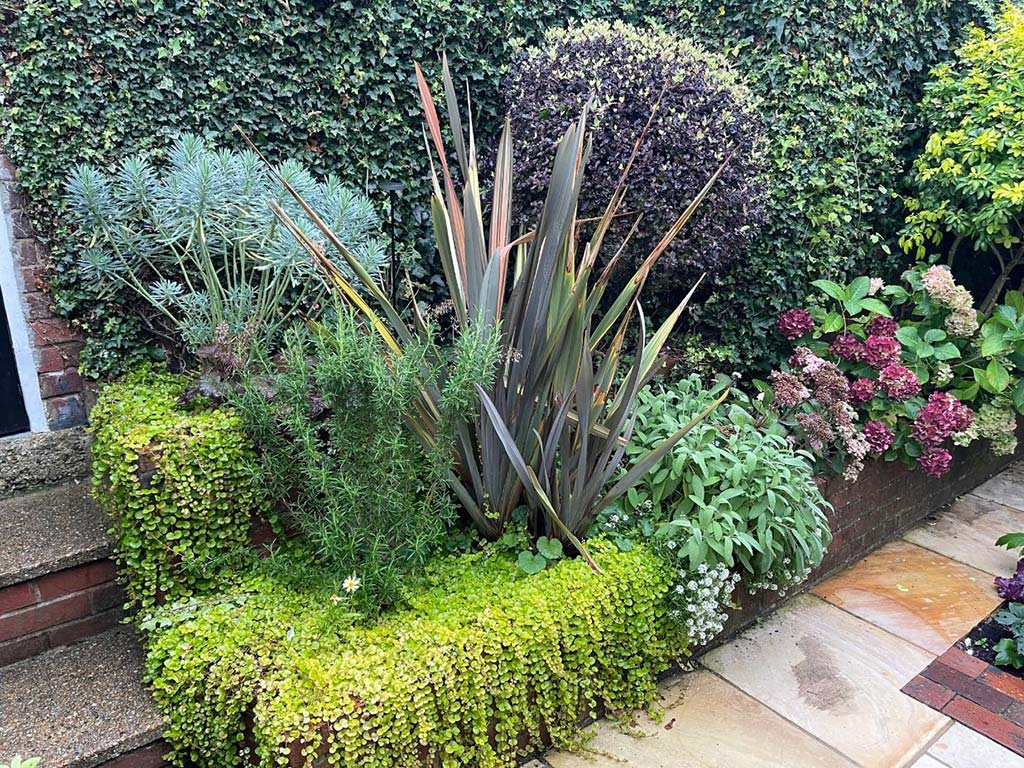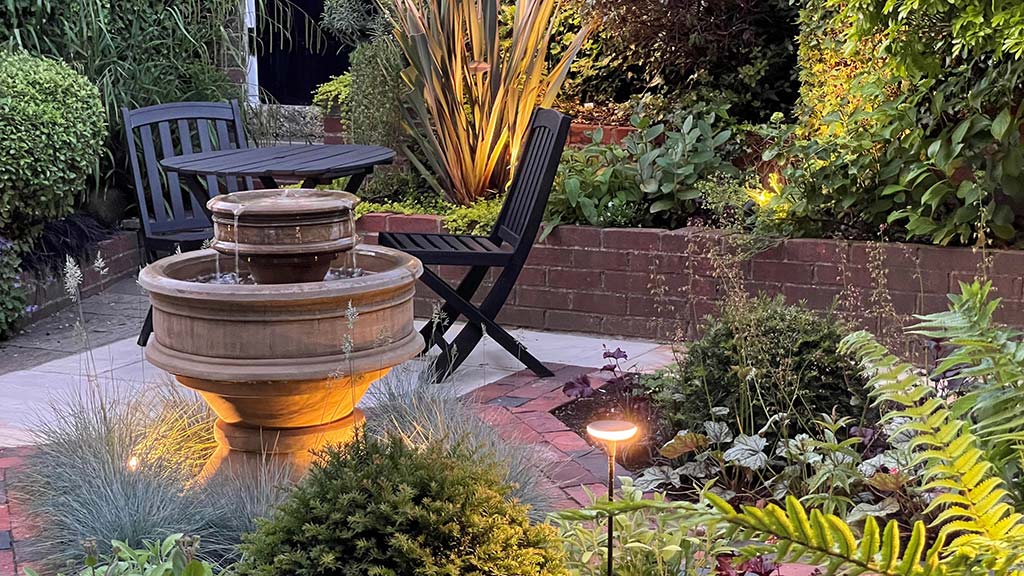Whether you have a courtyard garden at the front of your house as part of your entry sequence, or whether you simply have a small urban garden at the back of your house- there are opportunities to create an unexpected oasis. Pack a punch and make the best out of even the smallest of spaces by addressing its individual components:

Walling and boundaries
The most prominent feature of a small garden or courtyard garden is its vertical boundary since it takes up a large part of our field of vision as we look out onto the garden from the inside or, indeed, when we’re in it.
To create a verdant feel, consider evergreen climbers or boundary hedging instead of a fence, or hedging clipped tightly in front of a fence. Avoid exposing boundary materials that don’t contribute to the palette or look utilitarian. Where the structure of the boundary is exposed, it is best to make this a deliberate feature. This may be an existing wall with an attractive texture, or you can add cladding or Venetian batten screening. Use this as a stage for some feature planting, a group of pots, a sculpture or even a small water feature. Then light it well to create a focal point and some drama.
In any case, consider the angle from which you will mostly see your small garden: This will likely be somewhere from inside the house. Make sure that vista is interesting, restful and green, especially during the winter months.
Materials and style
First, it is important to decide whether your small garden or courtyard garden should be an outdoor living space where most surfaces are hard and where your planting is secondary, or whether you want to primarily create a lush garden feel.
If your space is very small, you may end up with the former out of necessity. Either way, embrace one or the other and commit to approximately 70/30 weighting overall towards either hard or soft surfaces, which will make for a pleasing proportion.
Be meticulous about detailing because this will be very obvious in a small space. It is an opportunity to be creative at a scale that would be lost in a large garden, so think about your materials transitions and the quality of the workmanship. Ideally, create a link to the building with your materials palette, even if you decide to vary the style of the outdoor space. If materials flow, a contemporary courtyard may contrast beautifully with a traditional building, and a cohesive and edited palette will seamlessly integrate the styles.

Image: Courtyard planting with colourful foliage and contrasting foliage textures (see case study)
Planting
In small spaces, it is important that your planting looks good at all times. Choose evergreens, limit colour and choose foliage over flowers. Play with the textures of contrasting foliage, repetition and grouping of plants to achieve a professionally designed look.
If you ditch the idea of having a lawn, you will be left with generous areas for planting and shrubs that add interest and dimension to your courtyard garden. If space permits, undulate the border to create deep pockets of planting and blur the boundary.
It is counter intuitive, especially for small spaces, but not being able to take in the whole extent of the garden at once makes the garden feel larger than it is. So, create layers with planting and don’t be afraid of big gestures in a small courtyard. Add a tree if you can and edit your planting scheme- bold mass planting can be very effective in smaller spaces.
Colour
Repeat a small number of plants to create a cohesive scheme. Remember that green is also a colour, and there are so many shades of it. In fact, the human eye can differentiate more shades of green than it can any other colour! Stick to 85% evergreen planting and choose shrubs like choisyas that have fragrant blossoms in addition to being evergreen. There is also ‘ever-grey’, ‘ever-yellow’, ‘ever-black’ and ‘ever-purple’ in foliage.
For flower colour, throw in blocks of proven work-horse plants like Geranium Rozanne to give you colour from May to November.
Another trick for a change of scene is to have one feature pot or carefully curated composition of pots that you plant up with bulbs in spring and one type of flowering seasonal plant. You’re looking for impact so resist mixing different plants for a designer look . The rest of the garden can be a supporting cast of green and textures.
Texture
Much of the pleasure we derive from well-designed gardens is created by the pleasing combination of textures: large leaves contrasted with small leaves, long with round, dense foliage with open habits and fine textures, and the solid shapes of clipped shrubs offset against the elegant silhouette of exposed branches.
Texture and colour are often combined in bark such as in the glistening red stems of the Tibetan cherry or the papery, chalky white of the birch tree, which provide great winter interest.
There is also texture and contrast in hard landscaping- natural stone faces or brick are enhanced by smooth sawn paving or velvety timber.
The trick to successful contrasting is to actually contrast, i.e., make sure that the characteristic you are showcasing is very different in two materials so that each enhances the other. One of the biggest mistakes is to go for too little contrast. Where this is most often overlooked is in the size and format of materials, such as a brick next to a stone sett of a similar size or where too many materials, formats and patterns are used. Material contrasts work best when applied with commitment and without distraction. Lastly, using value contrasts are an easy win: Light walls setting off dark green topiary or white birch bark in front of a dark green yew hedge
Perspective
There are tricks for creating the illusion of more space. One is to lay out the garden at a diagonal to the house or even just lay materials at an angle. This creates longer lines for the eye to follow and makes the space feel more expansive.
Another trick is to create false perspectives by exploiting how our eye expects smaller objects to be further away. This can be leveraged by placing pots or plants of the same style but different sizes in a way, where the larger specimens are closer to the main viewing angle, and the smaller ones are placed further in the distance.
Creating paths with edges that aren’t parallel but converge towards a focal point is another way this principle can be applied.

Image: Courtyard garden design with lighting (see case study)
Lighting
Lighting in courtyards is essential because, by definition, courtyards are visible from inside the house or on approach at night. Aim for creating cohesive pools of light or a general glow and avoid a spotty approach. At the same time, don’t over-light as it’s the dark areas that make the illuminated spaces and features pop.
Think composition: pick a feature as a main focal point, a well-formed tree, a sculpture, or a water feature. Use light to bring out the shape of the object. Experiment with up lighting, downlighting and how many lights you need to create the most dramatic effect. Textures are best grazed but remember grazing lights will also highlight unintended irregularities in seemingly smooth surfaces such as render. Use baffles where needed to reduce glare.
Finish off with a rhythmic repetition of lights in an odd group such as 5 evenly spaced lights along a path and your garden will look like a good painting.
If your space is big enough and a varied usage pattern warrants it, you may want to consider using a system that allows you to program different scenes. If you’re so inclined, include LED fixtures that can change colour, although a warm white will be classy and timeless while providing the most naturalistic colour rendering of your planting and hard landscape finishes